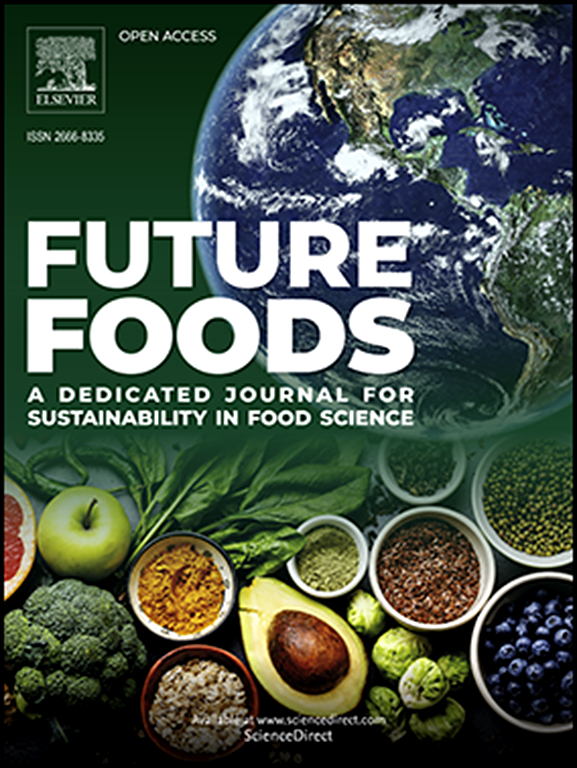Development of intelligent packaging from xyloglucan-chitosan modified film with betalains from dragon fruit (Hylocereus undatus) peels
IF 7.2
Q1 FOOD SCIENCE & TECHNOLOGY
引用次数: 0
Abstract
This study aimed to develop intelligent packaging films by, incorporating extracted betalain (EB) from dragon fruit peel into a tamarind seed kernel xyloglucan and chitosan blend (XC). The film were comprehensively characterized for their chemical, physical, mechanical, antimicrobial, and functional properties. Zeta potential and Fourier transform infrared (FTIR) spectroscopy confirmed that the interaction between xyloglucan, chitosan, and betalain were governed by ionic interactions and hydrogen bonding, which stabilized the colloidal network and influenced film microstructure. Increasing betalain concentration enhance film thickness and color intensity with scanning electron microscopy (SEM) revealing uniform surface morphology. Mechanical testing demonstrated that film with a 1:5 (w/v) EB:EC ratio achieved optimal performance balancing tensile strength (22.35 ± 2.25 MPa) and an elongation at break (185.07 ± 4.42 %). The films exhibited suitable barrier properties, with water vapor transmission rate (WVTR) and water vapor peameability (WVP) aligning with food packaging requirements. Antimicrobial assay revealed good activity against Escherichia coli and Staphylococcus aureus, while ammonia sensitivity test demonstrated the ability of film to detect spoilage via visible colorimetric shifts, correlating with total volatile base nitrogen (TVB-N) levels in shrimp. This study highlight the potential of XC-EB films as sustainable, intelligent packaging solutions for monitoring the protein-rich food freshness, leveraging agricultural byproduct to enhance food safety and reduce waste.

火龙果果皮甜菜素改性木葡聚糖-壳聚糖薄膜智能包装的研制
本研究旨在将火龙果皮中提取的甜菜素(EB)掺入罗望子仁木葡聚糖-壳聚糖共混物(XC)中制备智能包装膜。对膜的化学、物理、机械、抗菌和功能性能进行了全面表征。Zeta电位和傅里叶变换红外光谱(FTIR)证实了木葡聚糖、壳聚糖和甜菜素之间的相互作用受离子相互作用和氢键的支配,从而稳定了胶体网络并影响了膜的微观结构。通过扫描电子显微镜(SEM)观察,甜菜素浓度的增加可以增强薄膜的厚度和颜色强度,从而显示出均匀的表面形貌。力学性能测试表明,当EB:EC比为1:5 (w/v)时,薄膜的抗拉强度为22.35±2.25 MPa,断裂伸长率为185.07±4.42%。薄膜的水蒸气透过率(WVTR)和透气性(WVP)符合食品包装要求,具有良好的阻隔性能。抗菌试验表明,该薄膜对大肠杆菌和金黄色葡萄球菌具有良好的抗氧化活性,而氨敏感性试验表明,该薄膜具有通过可见比色变化检测虾体内总挥发性碱氮(TVB-N)水平的能力。这项研究强调了XC-EB薄膜作为可持续的智能包装解决方案的潜力,用于监测富含蛋白质的食品新鲜度,利用农业副产品来提高食品安全和减少浪费。
本文章由计算机程序翻译,如有差异,请以英文原文为准。
求助全文
约1分钟内获得全文
求助全文
来源期刊

Future Foods
Agricultural and Biological Sciences-Food Science
CiteScore
8.60
自引率
0.00%
发文量
97
审稿时长
15 weeks
期刊介绍:
Future Foods is a specialized journal that is dedicated to tackling the challenges posed by climate change and the need for sustainability in the realm of food production. The journal recognizes the imperative to transform current food manufacturing and consumption practices to meet the dietary needs of a burgeoning global population while simultaneously curbing environmental degradation.
The mission of Future Foods is to disseminate research that aligns with the goal of fostering the development of innovative technologies and alternative food sources to establish more sustainable food systems. The journal is committed to publishing high-quality, peer-reviewed articles that contribute to the advancement of sustainable food practices.
Abstracting and indexing:
Scopus
Directory of Open Access Journals (DOAJ)
Emerging Sources Citation Index (ESCI)
SCImago Journal Rank (SJR)
SNIP
 求助内容:
求助内容: 应助结果提醒方式:
应助结果提醒方式:


